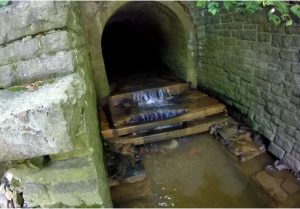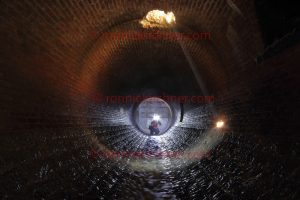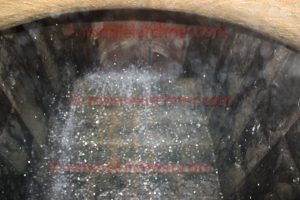
West side Storm Sewer Interceptor
Large interceptor storm sewer drain system built to drain out an area that was known to have many small streams and springs. A 2 fold problem existed, the old Druid Hill Avenue storm sewer was of insufficient capacity and the old McMechen Street Drain was already at over capacity. 2.1 meter (7 ft) oval , Brick Arched Culvert, with a masonry granite floor laid in American hydraulic cement 14 inches thick. This drains drops significantly in elevation along its course to outfall and accomplishes this via multiple vertical drop shafts or vertical drop wells (4 total).
Adventure/ Urban Exploration Video shot soley on a GoPro Hero+ and Canon T3i in this exact drain found below.
Vertical Drop Shafts featuring shafts constructed out of granite masonry that was laid 8ft x8 ft deep square outer diameter (OD), with final sizing 4ft x 4ft internal diameter (ID). The original iron cradles sit at the bottom of these shafts to smoothly drop the water from elevation to the floor. These iron cradles have proven to a very robust and enduring construction method. 1 significant junction chamber. Extensive small laterals. 1.5 percent grade.
In connection with the above were constructed the outfall of the sewer of heavy rubble broken range masonry at the west side of Jones Falls with its wing walls parapet and timber apron the four vertical drops eight feet square with cast iron inverts and the sides and ends faced with heavy dimension stone with depths of eighteen six and one half four and one half and five feet respectively the first two being excavated in hard and rotten rock requiring blasting On the line of the main tunnel four shafts were constructed to depths of 27ft, 43ft, 41ft, and 28ft feet respectively for the purpose of hoisting and lowering materials for the construction of the sewer Of the above there was completed during the year 1895.(ref a.)
Apparently this old storm sewer got in the way during the construction of a section of the B&P tunnel. Later they ended up utilizing it for the drainage of the train tunnel. Reference below.
Another unscheduled problem was encountered in the John Street Tunnel where a storm sewer crossed under the invert after following its centerline for about 200 ft. Originally an old brick-lined barrel and arch, its top had been partly uncovered, probably during invert work in 1916-1917, and slabbed over. Because this structure was at a higher elevation than indicated on the plans, it was severely damaged during invert scarification. (ref b.)
It should be noted that this particular drain had an incident of surging during its first exploratory documentation. The reason to this day is unknown. No precipitation was recorded that day in the area served by this storm sewer let alone watershed. Documentation exist that a section of the John Street tunnel, that passes near by requires water pumps to pump out a low lying area inside the tunnel. It specifically states that the water is pumped into a nearby storm sewer. It can only be assumed that it does so in intervals, such as like a sump pump behaves, which in turn would explain the sudden surge of water. Referenced to this coming soon. here: The sumps were located under the tracks at the south portal to cut off the entrance of outside water supplementing the original pumping chamber, and in the Wilson Street Tunnel just short of the rock line of the intersection with the tunnel invert. Water from the sumps is pumped to the city storm sewers. (ref b.)
REFERENCE
a.) Annual Report of the City Commissioner to the Mayor of Baltimore 1889
b.) Rehabilitation of Amtrak Baltimore and Potomac Railroad Tunnel in Baltimore, Maryland. Pg 31-33, June 1981



